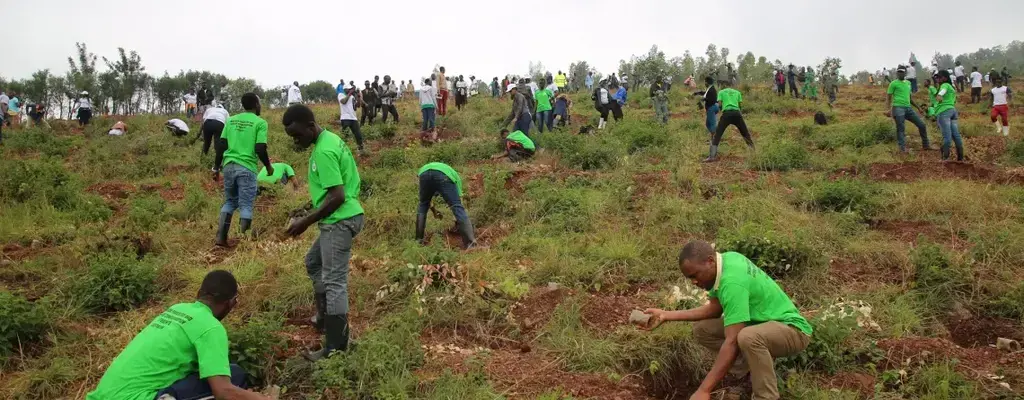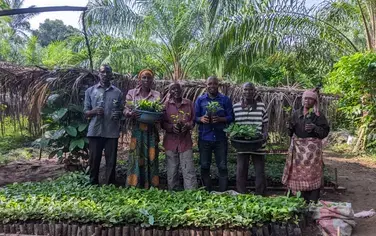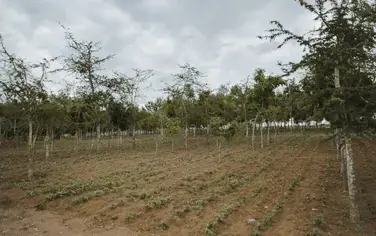Credit: Tree planting during the launch of Rwanda’s 2018/19 Tree Planting Season. Ministry of Environment, Rwanda.
This article was originally published by Landscape News.
Leveraging strong scientific and technical knowledge is essential to regreening the planet, said delegates during a conference on tree planting hosted by CIFOR-ICRAF and Resilient Landscapes. This is of particular importance in Africa, where countries have committed to restoring 100 million hectares of deforested and degraded landscapes by 2030 in the frame of the African Forest Landscape Restoration Initiative (AFR100).
Experts made it clear that good intentions alone will not result in enhanced livelihoods, more productive landscapes or an answer to the climate crisis. “When tree planting and forest restoration is done badly, all efforts go to waste and may even result in negative consequences,” said co-leader of ICRAF Tree Productivity and Diversity program Ramni Jamnadass. “Scientific and technological advancements increase the probability of success by helping us choose the right tree species for the right place and for the right purpose.”
The forum ‘Can tree planting save our planet?’ brought together researchers, forestry experts, community leaders and youth to discuss the need to turn planting pledges into long-lasting trees and forests – a critical step to support Africa in achieving its restoration goals.
FREETOWN, TREE TOWN
In words of keynote speaker Ivonne Aki Sawyerr: “We must keep the enthusiasm, but also the science.” As mayor of Freetown, Sierra Leone, Sawyerr has launched a three-year plan to address the city’s environmental issues in the spirit of the Global Green New Deal. One of her initiatives is ‘Freetown, a tree town,’ which she describes as “an ambitious but feasible and science-led initiative to plant 1 million trees in collaboration with the citizens.”
The initiative will plant trees from 15 Indigenous species in surrounding plains, mountains and mangroves to recover vital ecosystem services, and it will also regreen the city. With 1.2 million inhabitants – twice as many as 25 years ago – Freetown is pressed for open land area, so getting people to plant trees in their own backyards, schools and public spaces is another way of increasing the tree cover.
Citizens who volunteer as tree stewards will check in on the growth of ‘their’ GPS-tracked trees on a monthly basis and log the data into an app. The initiative, which is supported by the World Bank, hopes to reinstate ecosystem services that trees and forests used to provide before succumbing to the population explosion of the past decades.
A successful program will reduce the risk of erosion and flooding, improve access to water, and bring back bird and fish populations, says Saywerr.
ALL HANDS ON DECK
Sierra Leone is not alone in its fight. Every year, Africa loses nearly 3 million hectares of forests and 3 percent of its annual Gross Domestic Product (GDP) to soil and nutrient depletion on cropland. This means Africa has 700 million hectares of land that could be restored, the largest area of any continent. The AFR100 initiative is a contribution to the Bonn Challenge, which aims to bring 350 million hectares of degraded and deforested landscapes into restoration by 2030.
Goals may be global, but participants agreed on the fact that all activities are ultimately local and must be tailored to each site and community. “It is not about planting monocultures, but about empowering local people to make the right decisions about their landscapes,” said Thomas Crowther, professor at ETH Zurich and head of its Crowther Lab. “Also, communities must benefit from restoration projects for them to be sustainable.”
Speakers also noted the importance of having a holistic approach to tree planting and forest restoration: one that brings on board all relevant actors, seeks to stack as many environmental, social and economic benefits as possible, and takes into consideration all the technical tools at hand – from manual and drone-assisted tree planting to natural regeneration, use of spatial data and modeling.
“We need traditional environmental knowledge and science coming together, especially, in the face of climate change… a radically inclusive, all-hands-on-deck approach,” said Jad Daley, president and CEO of the conservation NGO American Forests.
Then there is the issue of political economy – the intersection of politics, economics and other considerations. Or as the chair of the Wangari Maathai Foundation Wanjira Mathai said: “We already know all that we need to know to take action, so why is it not happening?”
ICRAF Project Manager Susan Chomba agreed, pointing out that trees are important not only for carbon sequestration but also for biodiversity and sustainable development. “All of these objectives are linked.”




